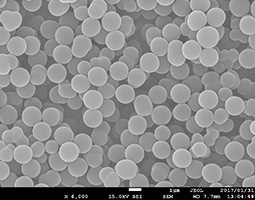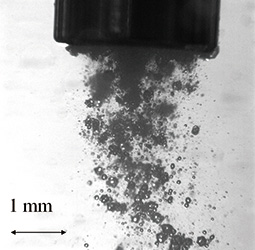Home > Highlighting JAPAN > Highlighting Japan December 2017 > Science & Technology
Highlighting JAPAN


The Mighty Power of Microbubbles
Microbubble technologies developed in Japan are having an impact in a wide range of fields, with hopes now high for their use in drug delivery systems.
Microbubbles” is a collective term for air bubbles with a diameter of 100 μm (0.1 mm) or less, studies into which began in Japan in the 1990s. Microbubbles are characterized by the extremely low rate of ascent of the air bubbles. For example, if the diameter is 10 μm, microbubbles ascend only about 3 mm per minute in liquid under stationary conditions, accumulating in the liquid for a long time. Large quantities of abundantly fine microbubbles are generated and the surface area in the liquid is large. Utilizing these characteristics, microbubbles have many applications including effluent treatment, cleaning, the aquaculture of fish and seafood, the hydroponic culture of vegetables, beauty care and home bathing.
“Ordinary air bubbles also have the effect of adsorbing dirt, but microbubbles are capable of adsorbing far more dirt because of their unique characteristics. Moreover, microbubbles do not have an environmental burden because they are not detergents,” says Toshinori Makuta, Associate Professor at the Department of Mechanical Systems Engineering, Graduate School of Science and Engineering, Yamagata University.
In addition to the adsorption of dirt, microbubbles are capable of dissolving a large amount of air into liquid. Cases have been reported where oxygen in a microbubble state was dissolved in water and used to improve agricultural harvests and the growth of fish. A mayonnaise has been commercialized with improved texture using the technology to stably disperse nitrogen in a microbubble state.
The technology for generating microbubbles has been advancing. Conventionally, microbubbles were mainly generated using a method in which gas and liquid were circulated at a high speed for shearing gas. Makuta has developed a method that uses a device known as a Hollow Ultrasonic Horn. This device integrates a titanium-alloy nozzle and vibrating body generating ultrasonic waves. When gas is sent into the device, the ultrasonic vibration generates a large quantity of microbubbles from the tip of the nozzle in a stable manner.
Makuta has been researching possible applications for the Hollow Ultrasonic Horn in a wide range of fields. One such application is enhancing bactericidal activity using ozone microbubbles, which are widely used for sterilization of tap water and food, and as a room deodorant. The experiment to date has shown that the amount of time for sterilization of Escherichia coli (E. Coli) in water is shortened substantially using the Hollow Ultrasonic Horn.
Moreover, conventionally, microbubbles were difficult to generate in liquid other than water. The Hollow Ultrasonic Horn however enables microbubbles to be generated in a variety of liquids, including molten metal. For example, Makuta successfully generated microbubbles using cyanoacrylates, which is the ingredient in instant adhesives. In general, even if cyanoacrylates are turned into steam and are put into water, they become hard immediately and no bubbles are generated. However, when the Hollow Ultrasonic Horn is used, microbubbles are generated and cyanoacrylates are solidified on the surface of the microbubbles. As a result, a microcapsule 2 μm in diameter with hollow construction is formed.
For example, this capsule can be applied to contrast medium in the medical field, which is administered to a patient during diagnostic imaging using an X-ray or ultrasonic wave. There are limitations to the visualization of blood flow with the current ultrasonography, but microbubbles have the ability to reflect an ultrasonic wave at a specific frequency, enabling blood flow to be observed more clearly. Another hoped for application of the microbubbles is as a drug delivery system in the treatment of cancer, directing anticancer agents to the required place in the required dose at the required time. Adverse drug reactions can be minimized by administering a microcapsule with anticancer agents adsorbed on its surface to cancer cells. An animal study of this system is currently underway, but the safety of a cyanoacrylate microcapsule has been established.
“I think that it will be possible to make drug therapy individualized for each patient. I hope to expand the network of experts in a variety of fields, including medicine and pharmaceuticals, advancing the study for practical applications,” says Makuta.
Currently, Japanese industry, government and academic experts are jointly promoting the foundation of an international standard for microbubbles under International Organization for Standardization (ISO) for the global development of microbubbles.
Microbubbles have the power to make a huge impact in the world.
© 2009 Cabinet Office, Government of Japan








